John Edyvean was a British engineer from Cornwall who developed an inclined plane system, to reduce the necessity for locks on the UK canal network.
In 1773, during the reign of George III, a plan was made to create a canal from Mawgan Porth, through various parishes including St Mawgan, St. Columb Major, Little Colan, and St. Columb Minor, to Porth. The project was meant to convey goods from the coast inland and eventually to the south coast.
However, Edyvean died before the project was completed at a cost of £100,000. An attempt to revive the scheme was made in 1829 by a Mr Retallick of Liskeard, but this too amounted to nothing.
Edyvean died in the 1780s. An obituary of the time in a monthly review related:

Newquay is a town on the north coast in Cornwall, in the south west of England. It is a civil parish, seaside resort, regional centre for aerospace industries, spaceport and a fishing port on the North Atlantic coast of Cornwall, approximately 12 miles (19 km) north of Truro and 20 miles (32 km) west of Bodmin.
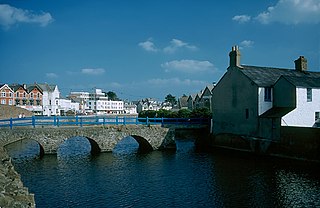
Bude is a seaside town in north east Cornwall, England, in the civil parish of Bude-Stratton and at the mouth of the River Neet. It was sometimes formerly known as Bude Haven. It lies southwest of Stratton, south of Flexbury and Poughill, and north of Widemouth Bay, located along the A3073 road off the A39. Bude is twinned with Ergué-Gabéric in Brittany, France. Bude's coast faces Bude Bay in the Celtic Sea, part of the Atlantic Ocean. The population of the civil parish can be found under Bude-Stratton.

The Bude Canal was a canal built to serve the hilly hinterland in the Cornwall and Devon border territory in the United Kingdom, chiefly to bring lime-bearing sand for agricultural fertiliser. The Bude Canal system was one of the most unusual in Britain.

St Columb Major is a town and civil parish in Cornwall, England, United Kingdom. Often referred to locally as St Columb, it is approximately seven miles (11 km) southwest of Wadebridge and six miles (10 km) east of Newquay The designation Major distinguishes it from the nearby settlement and parish of St Columb Minor on the coast. An electoral ward simply named St Columb exists with a population at the 2011 census of 5,050. The town is named after the 6th-century AD Saint Columba of Cornwall, also known as Columb.

St Columb Minor is a village on the north coast of Cornwall, England, United Kingdom.

St Mawgan or St Mawgan in Pydar is a village and civil parish in Cornwall, England, United Kingdom. The population of this parish at the 2011 census was 1,307. The village is situated four miles northeast of Newquay, and the parish also includes the hamlet of Mawgan Porth. The surviving manor house known as Lanherne House is an early 16th-century grade I listed building. The nearby Royal Air Force station, RAF St Mawgan, takes its name from the village and is next to Newquay Cornwall Airport. The River Menalhyl runs through St Mawgan village and the valley is known as The Vale of Lanherne. It was the subject of a poem by poet Henry Sewell Stokes.
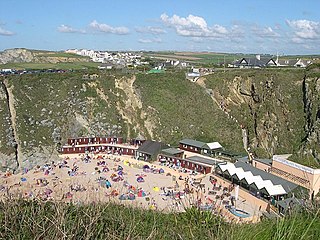
St Columb Canal sometimes referred to as Edyvean's Canal, was an abortive canal scheme in Cornwall, England, designed for the carriage of sea sand for use as manure. It was authorised in 1773, and part of it may have been briefly used around 1780.
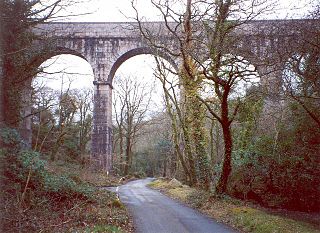
The Treffry Tramways were a group of mineral tramways in Cornwall in the United Kingdom, constructed by Joseph Treffry (1782-1850), a local land owner and entrepreneur. They were constructed to give transport facilities to several mines and pits producing non-ferrous metal, granite and china clay in the area between the Luxulyan Valley and Newquay, and were horse-operated, with the use of water and steam power on inclines, and at first operated in conjunction with the Par Canal and Par Docks, also constructed by Treffry. One of the routes crossed the Luxulyan Valley on a large viaduct, the largest in Cornwall when it was built.

Mawgan Porth is a beach and small settlement in north Cornwall, England. It is north of Watergate Bay, approximately four miles (6 km) north of Newquay, on the Atlantic Ocean coast.
Parnall's Canal was a half mile long canal that was built in Cornwall in about 1720 near St Austell. It was closed due to a rock slide in about 1732. It was one of only five canals to be built in Cornwall, the others being the St. Columb Canal from Mawgan Porth to St. Columb, the Liskeard & Looe Union Canal, the Par Canal from Pontsmill to Par, and the Bude Canal.

Lusty Glaze also known as Lusty Glaze Beach, is a beach in Newquay, Cornwall.
James Green (1781–1849) was a noted civil engineer and canal engineer, who was particularly active in the South West of England, where he pioneered the building of tub boat canals, and inventive solutions for coping with hilly terrain, which included tub boat lifts and inclined planes. Although dismissed from two schemes within days of each other, as a result of construction problems, his contribution as a civil engineer was great.
Arthur Ivan Rabey was best known as a Cornish historian and author from St Columb Major in Cornwall. He was also a journalist, broadcaster and local politician. In 1974 he was created a bard of The Cornish Gorseth and took the bardic name "Gwas Colum" meaning servant of St Columb. He died on 21 January 2008, aged 76, following a long illness.
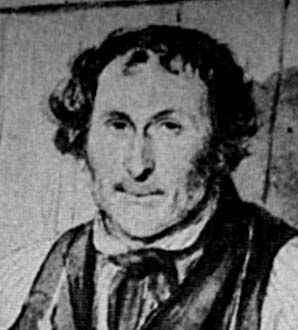
Richard Parkyn was a champion Cornish wrestler. He was born at Parkyn's Shop which lies at three parish boundaries, St Columb Major, St Columb Minor and St Mawgan. There was a saying at the time that Parkyn was "So great that all three parishes claimed him". He was also known as The Great Parkyn. Little is recorded about his life other than newspaper reports of his fights. "Parkyn, a friend of the Cornish hero James Polkinghorne died at Parkyn Shop where he and his ancestors resided during 170 years on 28 May 1855, aged 81 years."

The River Menalhyl is a river in Cornwall, England, that flows through the civil parishes of St Columb Major and Mawgan-in-Pydar. Its length is about 12 miles and it flows in a generally north-west direction. The name comes from the Cornish words melyn meaning mill and heyl meaning estuary - estuary mills. The name was recorded as Mellynheyl in the 19th century, but it had been known as Glyvion.
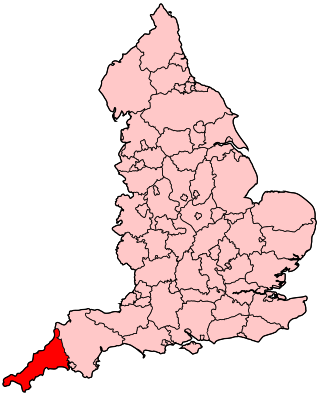
The following outline is provided as an overview of and topical guide to Cornwall: Cornwall – ceremonial county and unitary authority area of England within the United Kingdom. Cornwall is a peninsula bordered to the north and west by the Celtic Sea, to the south by the English Channel, and to the east by the county of Devon, over the River Tamar. Cornwall is also a royal duchy of the United Kingdom. It has an estimated population of half a million and it has its own distinctive history and culture.
The following is a timeline of the history of St Columb Major, Cornwall, England, United Kingdom.
Presented below is an alphabetical index of articles related to Cornwall:
Mawgan Porth Dark Age Village is a small ancient settlement consisting of 3 courtyard house complexes and a cemetery on the North coast of Cornwall dating from the 10th century. It was excavated in 1950-54 by Rupert Bruce-Mitford. The site was first discovered after the apparent after the discovery of the skeleton in 1934. The landowner. Mr P A Wailes, had wanted to build on the land and soundings to test the subsoil revealed the skeleton, stone walls, pottery and bone fragments.
'The Canals of South West England' by Charles Hadfield ( ISBN 0-7153-4176-6)